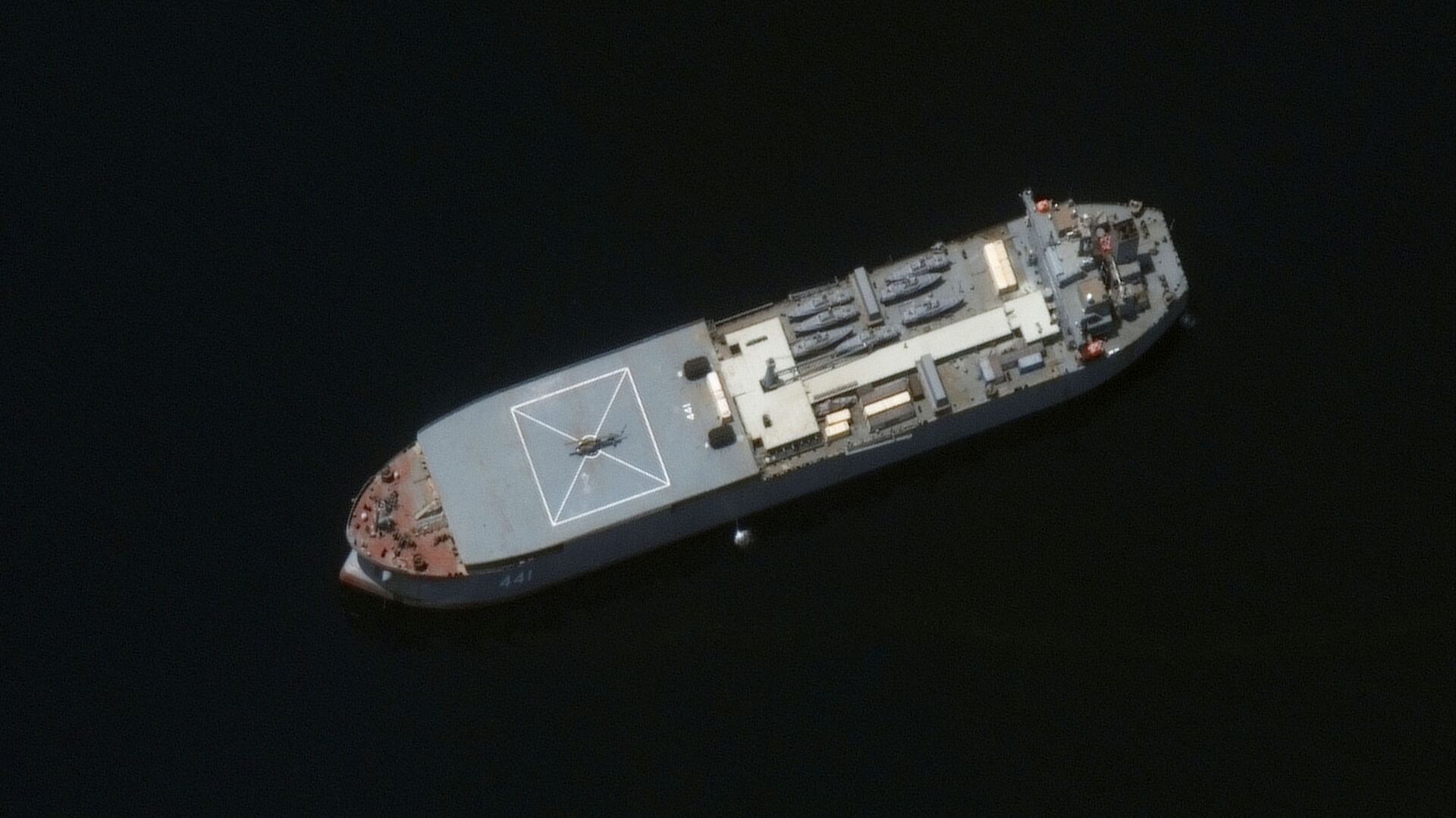Iran Plans to Build Another Long-Range Mobile Forward Base, Conduct New Trans-Oceanic Missions
16:22 GMT 14.09.2021 (Updated: 18:59 GMT 14.09.2021)

© REUTERS / MAXAR TECHNOLOGIES
Subscribe
A pair of Iranian warships recently carried out a 133-day, 45,000km trek across three oceans and continents, returning to their home port last Tuesday. Iranian officials and military leaders hailed the trip as evidence of the Islamic Republic’s growing naval might.
Iran plans to build a second mobile forward base such as the one which recently completed the long-range cross-oceanic journey across the world, Iranian Army commander Maj. Gen. Abdolrahim Mousavi has announced.
Speaking to Iran’s DEFA Press on Tuesday, Mousavi confirmed that a new vessel like the Makran forward base and support vessel would be created, and indicated that the experience gained by Iranian shipbuilders in the construction of warships, support vessels and other equipment will lead them to create such craft at an accelerated pace in the future.
The military chief also commented on the construction of new Iranian destroyers, saying that future warships will be equipped with more advanced systems than previous models to improve their long-range capabilities.
“The Navy, which wants to have an effective presence in all oceans, must be fully equipped and capable in terms of its equipment,” Mousavi stressed.
The Makran: Iran’s Budget-minded Mobile Sea Base
Iran’s Navy has mulled the idea of using commercial vessels for military since the late 1990s. Shipbuilders created the Makran out of a converted oil tanker, with the ship’s conversion taking just six months, and providing the Navy with the capability to conduct military operations virtually anywhere in the world – a historic first for the Islamic Republic. The Makran was launched in November 2020 and commissioned in January 2021. The 230-metre, 111,500+ tonne warship is capable of hauling fuel, troops, equipment, and an array of weapons. Virtually any road-mobile system designed for use by the ground, coastal and air defence troops, can theoretically be stationed on top of the Makran’s football field-sized deck. The ship can also carry small submersibles, reconnaissance UAVs and suicide drones, and helicopters, either above or below deck.

Iran's navy short-range missile drill
© AP Photo
The Makran’s permanent onboard weapons include Qadir and Abu-Mahdi cruise missiles, and a contingent of four small boats armed with Katyusha-style rocket launchers.
Iran has showcased the principle of a ‘roll-on/roll-off’ support ships in the past, placing Khordad-3 air defence missile systems on the deck of the Shahid Roudaki ocean-going vessel – created out of a converted cargo ship, and sailing them around. Khordad-3 is the same system that Iran used to down a $220 million US spy drone over the Strait of Hormuz in 2019.
#Iran's #IRGC this morning have show cased there new roll-on/roll-off ship, converted into a pseudo defense system dubbed the "Shahid/Martyr Roudaki" equipped with;
— Aurora Intel (@AuroraIntel) November 19, 2020
- 8 anti-ship cruise missiles
- Bell 412 helicopter
- Ababil 2 suicide drones
- 4 speedboats
- 3rd of Khordad AD pic.twitter.com/lWTfYL4Fqp
‘Special Message’
The Makran was one of the two ships in the mini-armada that Iran deployed on its cross-oceanic journey this spring, with the other being the Sahand, a Moudge-class destroyer. The ships left their home port of Bandar Abbas in May, travelling southward through the Indian Ocean, past the Cape of Good Hope and into the South Atlantic. From there, the ships travelled north up the coast of western Africa, proceeding to Europe, passing the English Channel and on to the Baltic Sea and St. Petersburg, Russia. There, the Sahand took part in a parade dedicated to the anniversary of the Russian Navy. The ships then travelled back to Iran, completing the trip on 7 September.
Iranian officials have stressed that the pair of ships made the trip entirely independently, without needing to make port calls to fuel up or stock up on supplies. During the journey, the Sahand occasionally pulled up beside the Makran to take on fuel and, presumably, other provisions for its officers and seamen.
Here’s the visual of the MAKRAN. A closer look at her starboard/right side reveals the SAHAND vessel moving in for an STS (Ship-to-Ship) transfer of fuel while both steam northeast towards the English Channel. Thanks for spotting the SAHAND, @mhmiranusa pic.twitter.com/OsVbvD2M1r
— TankerTrackers.com, Inc. (@TankerTrackers) July 17, 2021
Mousavi and other Iranian top brass have repeatedly indicated that in addition to demonstrating the Islamic Republic’s growing naval capabilities, the flotilla’s global deployment was designed to “send a special message” to the United States. In July, Iranian Navy commander Rear-Admiral Hossein Khanzadi joked that although “the Americans have set up bases around us over the years… today they are terrified when we are 5,000km away. This fear is because the presence of Iran breaks the hegemony of the United States.”
On Sunday, Mousavi said that the flotilla's deployment “caused strategic bewilderment and confusion among the navy of global arrogance led by the American terrorists,” and proved that “no obstacle can stop the will of [Iran] to rise in the seas.”
During the trip, the Sahand and the Makran were initially believed to be headed to Venezuela, Iran’s strategic ally in Latin America. US officials and media feared that the ships may have been laden with weapons, or emergency fuel and other assistance meant to buck US sanctions. The publication Foreign Policy even pondered whether international law would allow the United States to “act” against the Iranian vessels somehow while they sailed through neutral waters. The magazine concluded that Washington could not do so.


